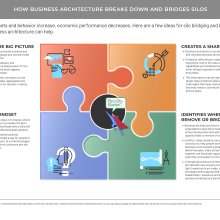What is business architecture good for? Perhaps many things come to your mind. It’s a great connector for building a common language. It’s a comprehensive business lens for making decisions. It’s a bridge for effectively executing strategy. And much more. These unique strengths make business architecture a powerful silo-buster. At the end of the day, silos are at the heart of many challenges and opportunities that business architecture and business architects can address.
Silos are in many ways just inherently human, but unchecked, they can become detrimental to an organization’s success. Business architecture is uniquely qualified to break down and bridge silos, as we will now explore.
What exactly are silos?
The silo mentality, the silo effect, the silo syndrome, silo-sitis. These are all terms for a condition that occurs when certain groups of people within an organization (e.g. business units, departments or teams) do not have a mechanism to share goals, priorities, information, processes or tools with other groups of people. And, to take this a step further, it may extend into a mindset where certain departments, teams or groups of people do not want to share with each other.
Simply stated, a group of people is considered to be working in a silo when its members work in a disconnected manner from other groups. A classic example of the silo effect is when two groups of people are working on practically the same thing, but neither is aware of what the other is doing.
What creates silos?
Silos can be created by organizational structure (e.g., within and across business units, departments and teams as well as up and down hierarchies) or by other factors such as geography (e.g., stemming not just from geographic separation but also time zone, language and cultural differences). Silos can also be the result of mindset, which stems from organizational leadership, culture, norms and motivational mechanisms.
What’s the big deal about silos?
Silos take hold of how we think and how we act.
“As siloed mindsets and behavior increase, economic performance decreases.”
— The Silo Syndrome, McKinsey
There we have it in black-and-white, backed by data: silos are not just a job frustration — they impact an organization’s ability to perform.
Silos create challenges for:
- Customers – Silos can create fragmented and inconsistent experiences for customers, which can lead to a lower level of customer satisfaction and loyalty. Our organizations’ internal fragmentation and dysfunction can translate into fragmentation for the customer. Take the example of changing your address with a company and you unknowingly change it with just one part of the organization that does not talk to others, so you continue to receive mail at your old address.
- Employees – Silos can frustrate and demotivate employees, leading to reduced morale, erosion of culture, lower productivity and attrition. Even when done well, navigating silos can increase collaborative overload for employees. According to data collected by HBR over the past two decades, the time spent by managers and employees in collaborative activities has ballooned by 50% or more. (Harvard Business Review, “Collaborative Overload”). At its worst, silo mentalities can lead to finger-pointing and blame as well as hoarding of information that is potentially valuable to the organization.
- The Organization – Silos can decrease efficiency (and increase cost) in a variety of ways, which can lead to an overall reduction in organizational performance, goal achievement and competitiveness. For example, silos can lead to:
- Decreased ability to make good decisions due to a lack of valuable information
- Decreased end-to-end organizational agility and the ability to execute strategy due to a lack of a unified vision and a cohesive capability to move ideas into action (More on business architecture’s role in strategy execution here in Posts No. 3, No. 50 and No. 9.)
- Impeded processing times due to slow handoffs, miscommunication and overhead
- Decreased quality due to errors, variability and rework
Increased risk due to a lack of transparency and coordination
How can we address silos and how can business architecture help?
Of course, it is important to understand the root causes for silos within an organization before applying solutions, but here are a few ideas for silo bridging and busting — along with how business architecture can help.
- Help everyone understand the whole. Especially in our connected world of today, everyone needs a holistic understanding of how the organization delivers value, to whom, and how things work at a high level. As described in the book Team of Teams: New Rules of Engagement for a Complex World, the European Space Agency failed because different countries made each part of the rockets. Independently the parts worked but when the rockets were assembled, they blew up. NASA avoided this problem by bringing their contractors in-house and mandating that everyone understand the entire project. People also need to have a common language, because not speaking the same language can isolate them into silos. For example, the language used by Sales versus Operations versus Legal versus IT can be very different in words and perspectives.
With business information concepts, capabilities and value streams at the heart (as well as other views such as the business model), business architecture helps by providing a shared context, language and mental model of an entire organization, that includes and makes sense to every area. It gives people a shared vocabulary and understanding of where they fit into the bigger picture — and what happens upstream and downstream. Business architecture also standardizes information concepts so that data can be standardized, aggregated and confidently relied upon for decision-making.
- Create a shared purpose. Without a common vision and objectives, employees and partners can be challenged to contribute appropriately to the organization’s goals and can feel disconnected from the bigger picture. Just having more collaboration is not enough – it requires a clear and shared understanding of the ultimate business direction.
Business architecture can be used to clarify and translate business direction. It helps by reflecting an organization’s objectives, tied to the value streams, capabilities and initiatives (as well as many other things) required to make them actionable. This information may be represented in a target state architecture(s) and strategic roadmap(s) that helps everyone understand how they need to contribute to the bigger picture goals.
- Identify where to remove or bridge silos. While it is not always possible or logical to remove silos, sometimes it makes sense. Or, identifying where and how to best bridge silos can be useful, such as where there are information, process, tooling or cultural gaps.
The value streams and capabilities of business architecture – and their connection to other business architecture domains (e.g., objectives, business units, products, policies, stakeholders, initiatives, etc.) as well as the operating model (i.e., people, process and technology) – provide an ideal enterprise business lens with which to identify opportunities to remove or bridge silos. For example, value streams can provide an additional construct to help people work together across business units towards a greater goal of delivering value. Value streams and capabilities together can illuminate opportunities for sharing expertise, processes or tools. Leveraging business architecture for initiative prioritization and scoping can ensure that the right investments are made in alignment with strategic priorities, shared solutions are leveraged where appropriate, and that the right stakeholders, sequence and integration points between initiatives are identified upfront. An organization’s business architecture extends beyond its organizational boundaries to include customer and partners, so any silo challenges in the extended ecosystem can also be analyzed and addressed.
- Change the mindset. Potentially the most effective way to break down and bridge silos starts with our mindset. This includes openness, sharing, collaboration, transparency, empowerment and truly caring about the customer and the entire enterprise and its mission. Of course, these changes are hard work. Shifting the mindset from silos to enterprise and collaboration starts with leaders and needs to be backed by the right incentives and motivational mechanisms.
Business architecture does not change culture or mindset directly, but it provides the facts and transparency to illuminate where silos still exist so they can be addressed appropriately. As a truly shared enterprise business framework, it also provides a way for people to come together in support of something bigger than themselves to serve customers and the organization’s mission.
All of this is summarized in a handy diagram here.
One of the most important things we can do as business architects is to leverage business architecture along with our talents and care to help break down and bridge the silos within our organizations. Business architects are perfectly positioned to be Enterprise Advocates. If not now, when? If not us, who?
More Good Stuff
The Silo Syndrome (McKinsey): A simple, visual and powerful explanation of some silo challenges and solutions.
The Silo Mentality: How To Break Down The Barriers (Forbes): An overview of the silo mentality and five ways to encourage a unified front.
A Radical Solution To The Silo Problem (Forbes): An experiment to break down silos by rotating team members into each other’s roles. A very interesting read.
The Silo Effect: The Peril of Expertise and the Promise of Breaking Down Barriers (Gillian Tett): This book applies an anthropologist’s lens to the problem of why so many organizations still suffer from a failure to communicate. It shares tales of the silo syndrome, yes, but also shows how institutions and individuals can master their silos instead.
Collaborative Overload (Harvard Business Review): Collaboration is great, but recognizing, promoting and efficiently distributing the right kinds of collaborative work is important.
Team of Teams: New Rules of Engagement For a Complex World (General Stanley McChrystal with Tantum Collins, David Silverman and Chris Fussell): An excellent book with compelling examples of how the team of teams strategy has worked everywhere from hospital emergency rooms to NASA. These concepts have the potential to transform organizations large and small.
Silos Into Sousaphones (TED Talk): An important TED Talk by David Healey, David Healey Director of the Boston College Marching Band and the Symphonic Band who speaks about breaking down the most important silos of all: human diversity. David’s talk describes his mission to successfully and consistently unite vastly diverse communities through teamwork and compassion, turning academic communities into more than just places where people study. There are some very good lessons to take away from this one.

